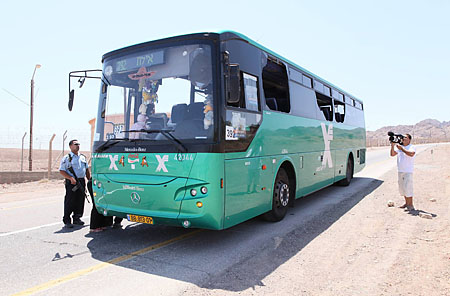
Bus 392 stands on the highway running from Beersheva to Eilat, with windows broken following a gun attack on August 18, 2011 near the Israel - Egypt border, Israel. (Photo: Yehuada Ben Itah / Getty Images)
What headlines described as a terrorist attack in the desert just north of the Israeli resort city of Eilat was in fact a sustained assault, a complex military attack that included missiles, mortars, improvised explosive devices, small arms and, on the bodies of two of the seven assailants killed, explosive vests. Israeli security officials had been tracking the militants from the Gaza Strip, where plans were laid for the attack, into the lawless Sinai desert that since the fall of Hosni Mubarak has offered a more and more accessible back door to Israel. But somehow, the militants found a way to strike first, killing seven Israelis on a lonely desert highway.
“It wasn’t supposed to end this way,” a senior Israeli intelligence officer tells TIME. “And now we have to find out why it didn’t end the way it should have.”
No group claimed responsibility for the attack, but barely six hours later the Israeli military bombed a Gaza target associated with the Popular Resistance Committees, a militant group formed from the more militant remnants of the secular Fatah faction driven out of coastal enclave by Hamas four years ago. Within an hour, three rockets were fired from Gaza toward the Israeli coastal city of Ashkelon. They were knocked out of the sky by the Israeli anti-missile system known as Iron Dome, but the tit-for-tat exchange raised concerns about military escalation between Israel and Hamas, which disavowed the attack but which Israel holds ultimately responsible for threats emerging from the enclave

